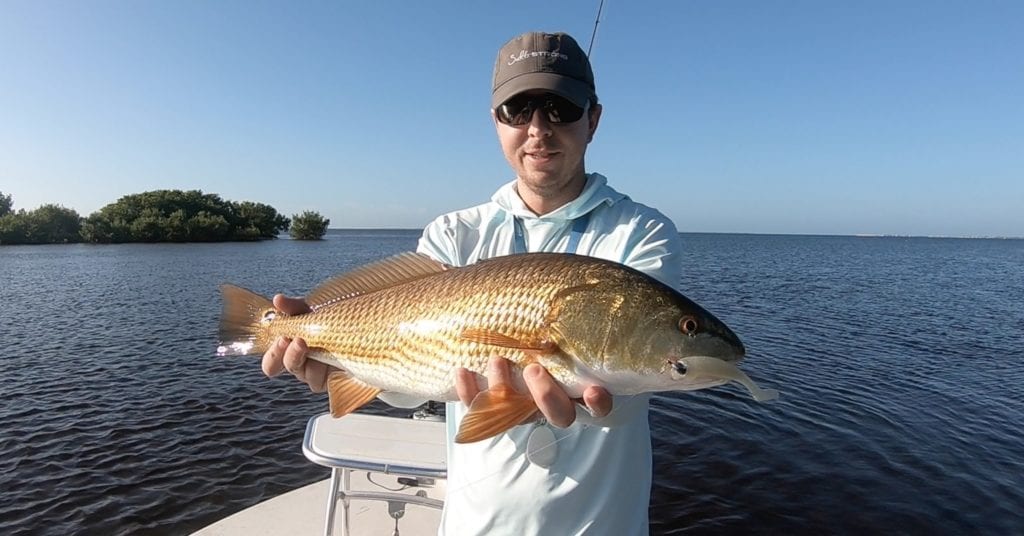How To Catch An Inshore Slam In 20 Minutes (Even In A New Spot)
- By: Luke Simonds
- on

First cast…
Boom!
A fun topwater trout.
Just as planned, right?
Of course, things don’t always go as planned…
Sometimes you have to wait an hour or two for the first bite…
Or go to four or five different spots…
And sometimes that first bite never comes at all and you go home skunked!
But there’s one shortcut to catching fish that trumps all the other tips.
Armed with two lures, a handful of spots picked from ten minutes on Google Maps, and this one shortcut, I caught an inshore slam in twenty minutes, plus loads more snook and redfish in a spot that I’d never been to.
Want to know what that shortcut is?
Watch the video below.
Catching An Inshore Slam In 20 Minutes [VIDEO]


We’ve talked to hundreds of professional tournament anglers and fishing guides and asked them why they’re so successful, and one of the reasons that always comes up is this…
They have a network of anglers that they can rely on to get the most up-to-date fishing trends.
Before they go out on a trip, they’ll ask their friends what the fish are doing, and they’ll share something like this…
“The fish are holding in tight to the mangroves, so cast as close to them as you can…”
Or, “After this latest front, the fish have started to move back into the backcountry, and there aren’t as many out on the flats now…”
Now, this isn’t just sharing spots, but trends that help you decide which spots the fish are likely to be in.
Because of the trends I got from the Insider Club, I was able to go out and catch tons of snook, redfish, and trout in a short two and a half hour trip, in a spot that I’d never been to.
Conclusion

If you want to spend more time in the feeding zones, and less time in the dead zones, and you aren’t on the water every day, then you need a fishing network to help you stay up with the latest fishing trends.
This simple tip is what helps many professional anglers be so successful, and can help you catch more fish than you ever imagined.
Of course, creating a network of anglers is hard to do, so we’ve done it for you.
The Insider Club has over 9,000 anglers from Texas to Virginia and we’re all sharing the most up-to-date trends so that we’re all catching more fish and having more fun on the water.
Click here to learn more about the Insider Club and join today.
Do You Want To Quickly Find New Fishing Spots In Your Area?
Then you’ve got to see this private fishing club!
Here’s what you’ll receive today:
- Weekly fishing reports and TRENDS revealing where the inshore fish are feeding all year long
- Weekly “spot dissection” videos that walk you through all the best spots in certain areas
- Exclusive fishing tips from the PROS you can’t find anywhere else
- Everything you need to start catching fish more consistently (regardless if you fish out of a boat, kayak, or land).
Click here to join today.
Related articles:
Related categories:
STOP WASTING TIME ON THE WATER!
Do what the “SMART ANGLERS” are doing and join the Insider Club.
Here’s what you’ll receive today when you join:
- Weekly fishing reports and TRENDS revealing exactly where you should fish every trip
- Weekly “spot dissection” videos that walk you through all the best spots in your area
- Exclusive fishing tips from the PROS you can’t find anywhere else
- Everything you need to start catching fish more consistently (regardless if you fish out of a boat, kayak, or land).










Luke,
What fish are you saying you have to catch to consider it a slam?
Captain Don
There are many sets of 3+ species that are considered slams. Around here, the main inshore slam that is most popular is redfish, seatrout, and snook. Here’s a post showing a variety of slams in case interested: https://saltstrongdev.wpengine.com/articles/saltwater-fishing-slams/
Luke, at times I am unsuccessfully fishing inshore areas that seem to have all the components of an ideal spot (flow, structure and bait). When this happens (and seems to be often) I chalk it up to the fish aren’t feeding despite the appearance of feeding w/ regular jumping (or generally I’m not reading the feeding trends accurately/correctly). In addition to changing locations, do you have suggestions for such a scenario? Thank you!
The most common reason for fishermen who are getting into good spots but still not catching fish is caused from incorrect habits when approaching the spot and/or when positioning their location to present the lure/bait to the fish. We build a course that covers the details on exactly what to do… here’s a link in case you haven’t yet seen it: https://saltstrongdev.wpengine.com/positioningcourse/module-1-overview-big-idea/top-factors-big-idea/
The 2nd most common reason for this is that the angler is not presenting the lure/bait at the right depth, direction, and/or speed. When in doubt, cover the bottom because that’s where most of the feeding from ambush predators like redfish, seatrout, snook, flounder, etc. takes place.
What lures/baits have you been throwing in the last two instances where you found yourself in a good looking spot without any action?